My travel blog launched on June 26, 2020—right in the middle of a pandemic when no one was traveling. It took me a couple of months to get the hang of things, but once I got my bearings, I started taking my blog seriously in October 2020.
Despite starting my travel blog in the middle of a pandemic, in less than one year, my blog has reached 10,000 monthly pageviews. I recently shared some of my blogging milestones & success on my social media, and I received an overwhelming response to share my tips & tricks for growing a travel blog from scratch. So, I decided to compile my past year of learning into one concise blog. I hope this post about how to start a travel blog & make it grow is helpful, and I hope it teaches you something new!
My Blogging Journey
Before diving into my travel blogging tips, I thought it would be helpful to share a bit of my journey that’s led me to where I am today!
I started my blog while working part-time as a communications manager and part-time as a freelance copywriter. It combined two of my loves, writing & travel, to create a fun hobby, and I also hoped it could serve as a resume of my work for potential freelance clients.
After my first few months of travel blogging in July and August of 2020, I hit a wall in September. I felt a lack of inspiration, and I was feeling defeated because no one was reading my blog. I was really close to throwing it in the towel. It didn’t seem worth it to keep spending my limited free time writing when no one was reading what I was putting out there.
However, after an awesome trip in October 2020 to Charleston, Savannah, and Asheville, I decided I was going to give travel blogging another try—and do it the right way. I started focusing on posting consistently and investing my time into things like SEO and Pinterest, instead of just posting to my blog, throwing up an Instagram post, and hoping people would read it.
By mid-2021, my consistency started to pay off. I started to watch my pageviews increase rapidly each month, my blogs were ranking on Google’s first page for large keywords, and I was able to begin monetizing my website. As I’m approaching one year of travel blogging consistently, I’m also approaching 10,000 monthly pageviews!
Since July, I’ve been a full-time freelance copywriter & travel blogger. I’m able to devote more time to my website, and I am so excited about what the future holds!
As someone who almost quit blogging just three months in after seeing zero results, I wanted to write this post to encourage aspiring travel bloggers that you CAN be successful and see results with determination, consistency, and the right marketing skills. If you’re wondering how to start a travel blog and actually see results—this post is for you!

How to Start a Travel Blog: 8 Tips to Get Your First 10,000 Pageviews
Tip #1: Invest in Your Website
Although this post is more heavily focused on how to grow your blog once it’s already established, it’s worth mentioning that setting up your website correctly is key to having success as a travel blogger.
Kiki from The Blonde Abroad has a really awesome post that details how to set up your domain and hosting, how to set up your blog on WordPress, how to connect your Google Analytics, and other key tips for setting up your travel blog correctly. You can read her tips here.
I’m also fortunate that my husband is a digital marketing specialist & web designer, so he was able to help me set up and build my website correctly. Thanks, PEG Creations!
Tip #2: Complete SEO Research
Once your blog is set up, one of the most valuable skills you can learn as a travel blogger is search engine optimization (SEO). SEO is the practice of improving the quantity and quality of web traffic to your website and helps your website be seen by people searching for your content.
Although your web pages need to be SEO optimized, it’s even more critical for your blog posts to be optimized for SEO. This means that your blog posts need to contain keywords that your ideal audience is searching for. Here’s an example of how I would perform keyword research before writing a post:
Let’s say I have an idea to write a blog post about the best things to do in Waikiki. First, I would open Ubersuggest to do keyword research. I use the paid version, but the free version works great, too!
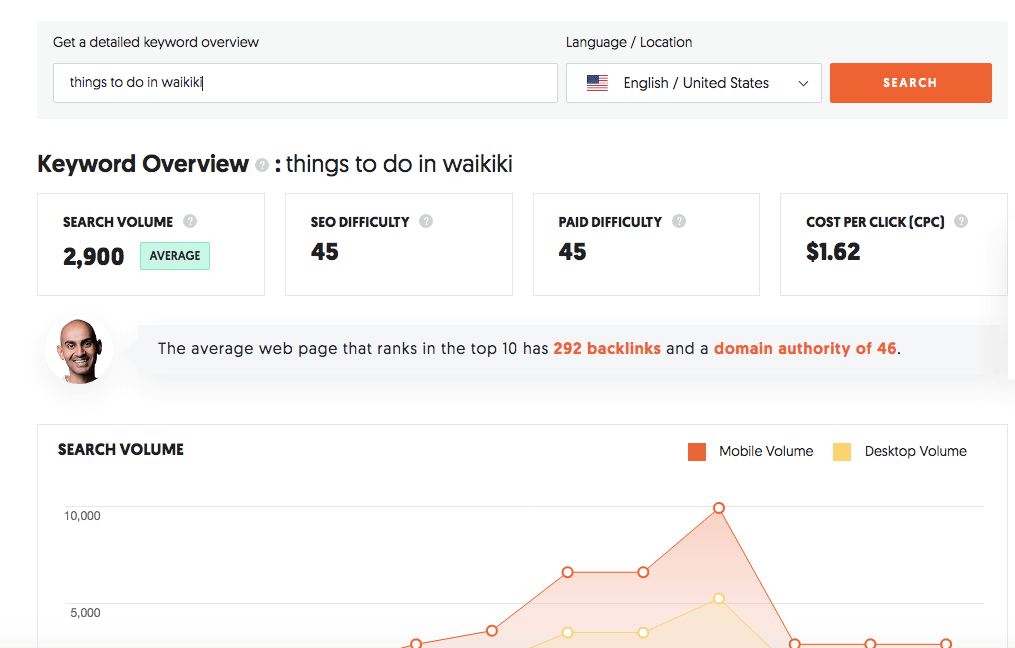
As you can see, under the “Keyword Overview” tab, I typed in the keyword “things to do in Waikiki.” According to Ubersuggest, that keyword has a Search Volume of 2,900 and an SEO Difficulty of 45 (out of 100). That means that every month, 2,900 people are searching for this term, and it’s moderately difficult for a post with this keyword to rank on the first page.
Usually, you want to use keywords that have a high volume and a low SEO difficulty. This means it will be easier for your blog to rank on Google’s first page, and more people will see it when it’s there! As your blog grows, you will be able to shoot for keywords with even higher volumes and more significant SEO difficulties.
If the keyword you initially type in isn’t great for the phase your blog is at, that’s okay. You can scroll down to the Keyword Suggestions and Related Keywords tabs to get some additional keyword inspiration.
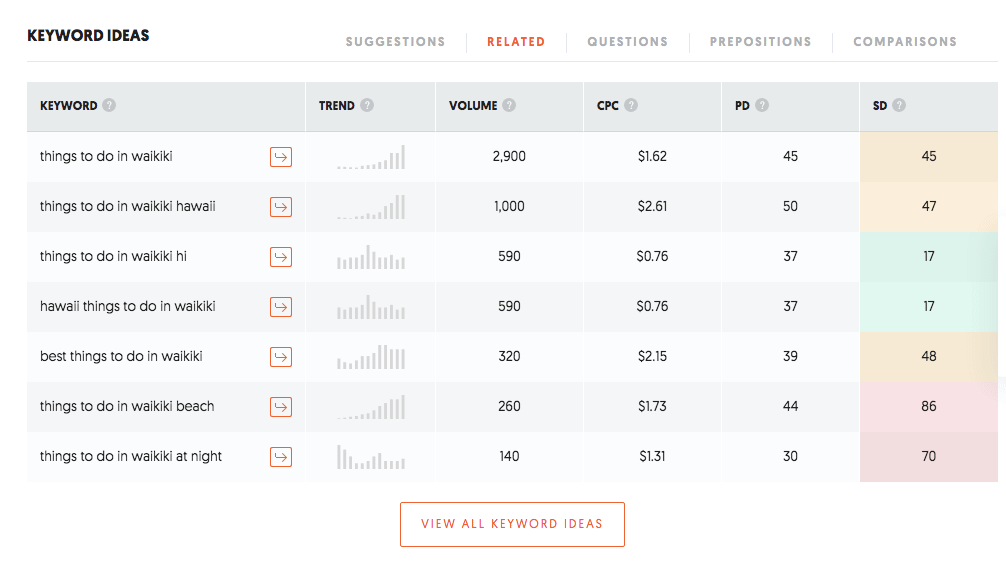
Here are some of my other tips regarding SEO research for travel blogging!
- Research before traveling. Complete keyword research before traveling to determine what topics you’ll want to write about when you get back. Then, you can guide your travels around your blog posts, instead of piecing together random blog posts when you get back that don’t have great SEO value.
- Use high-volume keywords. When you’re writing, switch off between using higher volume keywords and lower volume keywords. You never know when a super high-volume keyword will rank!
- Publish seasonal content. Remember that travel is a seasonal topic. Certain destinations are more popular at certain times of the year. Publish seasonal content 3-4 months in advance so it has time to rank on Google when the season arrives. For example, you should publish an article about “Best Places to Visit in Europe this Summer” in February or March, so when people begin to plan their trips, you’ve already given Google time to crawl your page (aka, have rank for SEO keywords).
- Use secondary keywords. When you’re writing a blog post, use one primary keyword (more on this below) and a few secondary keywords that may rank, too. For example, a great secondary keyword for “things to do in waikiki” might be “best things to do in waikiki” or “things to do in waikiki hawaii” or even “things to do in honolulu.”
Tip #3: Write for SEO
Now that you’ve done your SEO research, it’s time to write your blog post! It’s key to correctly incorporate the SEO keyword you’ve chosen into your blog post correctly.
To make things easier, I suggest downloading RankMath on your website. I use the free version, and it helps to scan for factors that impact your SEO ranking, like keyword incorporation, readability, the effectiveness of your title, and more. It ranks your post on a score of 0 to 100 on the SEO-friendliness of your post. Here’s how it looks:
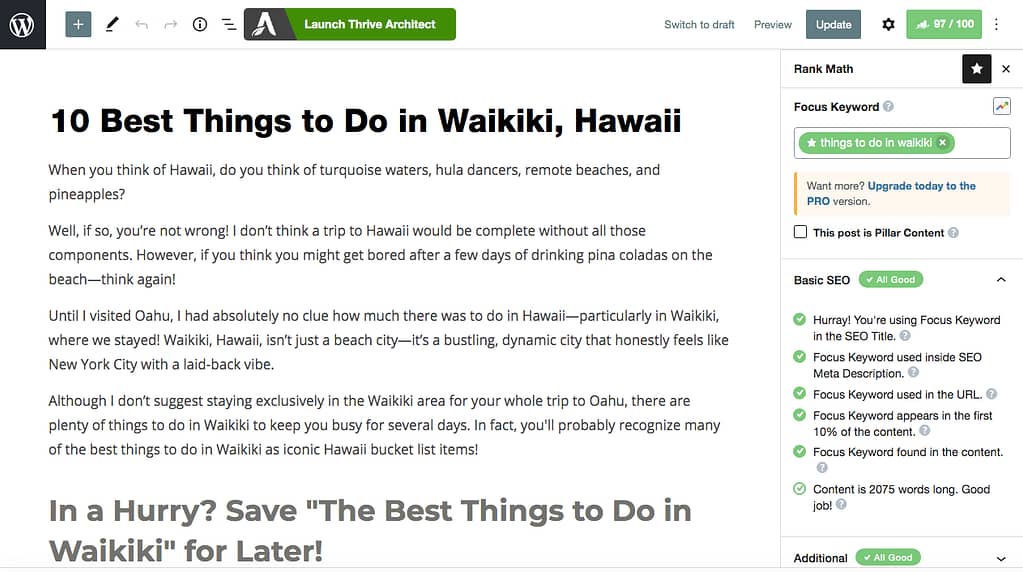
These are my general best practices for writing SEO-friendly blog posts. If you’re using RankMath while writing, they will scan your post for many of these elements and also give you tips to improve your content.
- Provide helpful information. If you’re using your blog as a diary to tell personal stories and anecdotes, that’s great. However, your blog will never rank unless you offer valuable content that helps your target audience. Unless your experiences can tangibly help your audience, try to exclude personal narratives from your blog.
- Write long-form content. Long-form content is any piece of writing that exceeds 1,000 words. Google tends to prefer long-term content over short-form content because it tends to provide more value to readers. Focus on producing long-form content to improve your SEO score.
- Create scannable content. It’s a sad truth, but no one will read every single word of your blog post. It’s critical to incorporate bullet points, bold content, sub-headlines, photos, and short paragraphs to keep your reader engaged.
- Incorporate your keyword. Add your keyword to your SEO title, meta description, URL, subheadings, sub-headlines, alt image text, and consistently throughout your blog copy.
- Write a catchy title. Try to include a “power word” (like “best”) and a number in your SEO title, if possible.
- Use questions as subheadings. Try to use FAQs about the topic you’re writing about as subheadings. Google tends to like blogs that do this, and it also helps your reader find what they’re looking for.
- Become a subject expert. If you can become an expert on a topic, you can link tons of other blog posts you’ve written to the blog post you’re writing. For example, I have four different blog posts I could link within my “Best Things to Do in Waikiki” blog. This process is called internal linking.
Tip #4: Master Pinterest
If you’ve ever thought of Pinterest as another social media platform—think again. Pinterest is a powerful search engine that can help drive traffic to your website, and it’s essential for success as a travel blogger—especially when you’re starting!
Here are some of my pin statistics for one of my most popular posts on Pinterest, 12 Things to Do During a Day Trip to Sedona. As you can see, this pin has resulted in 1,160 outbound clicks to my blog. And that’s just over the course of one month!
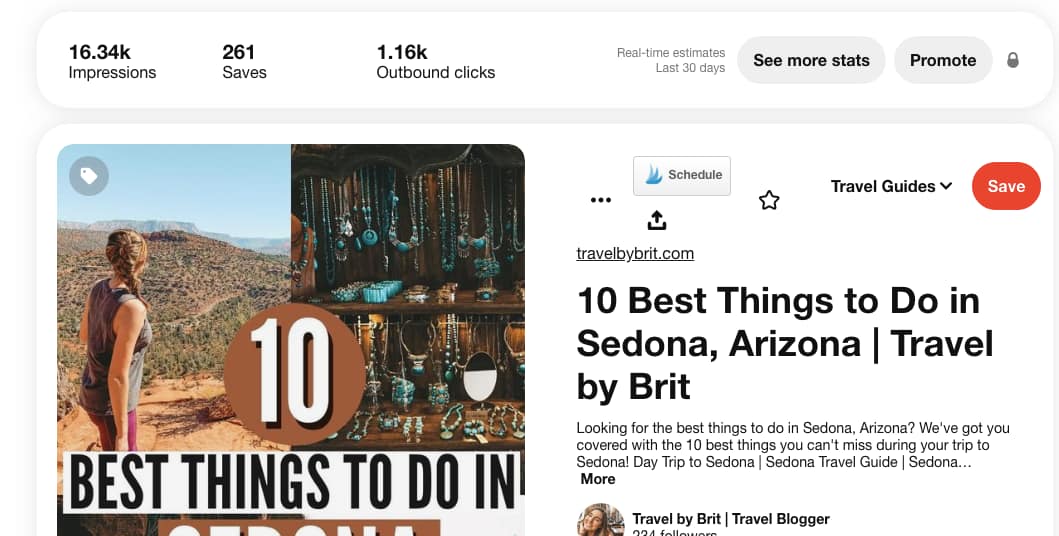
Here are some of my best tips for Pinterest that have personally worked for me over the past year:
- Join Pinterest groups. Pinterest groups allow you to share your pins in an exclusive community to boost a pin’s engagement. I have a Pinterest group called Team Travel Blog Babes, if you’d like to join!
- Create attractive pin covers. It’s crucial to create attractive pin covers that will grab your target reader’s attention. Canva is an excellent free tool you can use to create great pin covers. The key is to use easy-to-read text and high-quality images. I’ve also found that it’s helpful to include a number on the pin.
- Pin daily. It is essential to share at least one fresh pin per day—a new image you’ve never pinned before. You should create 10-20 pins for each piece of content you produce. I typically make my pins in batches per blog post, and I schedule out one per day using the Pinterest Scheduler tool.
- Re-pin daily. It’s also important to re-pin at least 10-20 of other’s people’s pins per day. I usually re-pin using the Pinterest groups I mentioned earlier or the Pinterest thread on the Wandering Women Travel Bloggers Facebook Group (more on this below).
- Complete keyword research. Just like Google or Internet Explorer, Pinterest is a search engine, so you’ll need to complete some keyword research to discover which words to incorporate in your pin descriptions, alt image text, and titles. I typically type a general phrase into the search bar (like Waikiki Hawaii) and see what related words pop up that I can use as relevant keywords.
Tip #5: Join Facebook Groups
Facebook groups have been a super helpful way to grow my travel blog and make valuable connections with other travel bloggers. Two of my favorite Facebook groups for female travel bloggers are Wandering Women Travel Bloggers and Women Travel Creators (formerly known as Female Travel Bloggers).
Here are some of the most valuable ways you can leverage a Facebook group to grow your blog:
- Blog Post Saturday. On Saturdays, these Facebook groups allow you to post a link to one of your blog posts. You can engage with other people’s blog posts in return for engagement on your own.
- Pinterest Thursday. The Wandering Women Travel Bloggers group does a Pinterest thread on Thursdays where you can drop a link to one of your pins. In exchange, you have to pin everyone else’s link, and everyone will pin yours. I use this thread as one of my “resources” for daily pins.
- Blogger Support. Chances are, if you’re reading this, you may have some questions about blogging. These groups are an excellent place to ask questions to a large group of travel bloggers with tons of experience. I’ve learned so much from reading the answers to other people’s questions, and I’ve done some valuable networking, too!
Tip #6: Collect Backlinks
Another lesser-known (but essential!) way to increase traffic to your travel blog is to develop a solid backlink strategy to increase your domain authority (DA).
Your domain authority is essentially a number on a scale of 0-100 that indicates how well your content will rank on search engines. The way you can grow your DA is by collecting do-follow backlinks from relevant sources, like tourism boards, travel websites, and other travel bloggers.
When you add links to your blog, you can choose to make them do-follow or no-follow. Do-follow links help boost your SEO by passing the authority of the origin site to the destination site. So, if you have a do-follow link to your website on a popular website, their authority is passed along to you. Gathering multiple do-follow backlinks helps improve the overall domain authority of your website, but it also helps the blogs with backlinks rank better on Google.
You can check your domain authority on Moz for free. My domain authority jumped from zero to 13 in one year by doing the following:
- Writing guest posts. Many experienced bloggers with high DA scores are looking for other bloggers to write entire posts for their blog. In exchange for your writing, you will often be able to negotiate a few do-follow backlinks in return!
- Participating in collaborative posts. Many bloggers put together guest posts (like this one) that allow multiple bloggers to contribute a small 200–250-word excerpt for a do-follow backlink to a relevant post. These are great for boosting your DA and don’t take long at all! I typically track the backlinks I’ve collected in Google Sheets.
- Exchanging backlinks. The quickest way to boost your DA is to exchange backlinks with other travel bloggers and websites with a higher DA than you.
I recommend the Travel Collabs & Link Swaps and the Travel Collab Post Opportunities Facebook groups as a great place to start when looking for link swapping opportunities.
Note: Google can also tell when you’re being spammy and will penalize you for it. Try to include backlinks contextually in your post as they make sense, and try to avoid link swapping or guest posting for the same people over and over again.
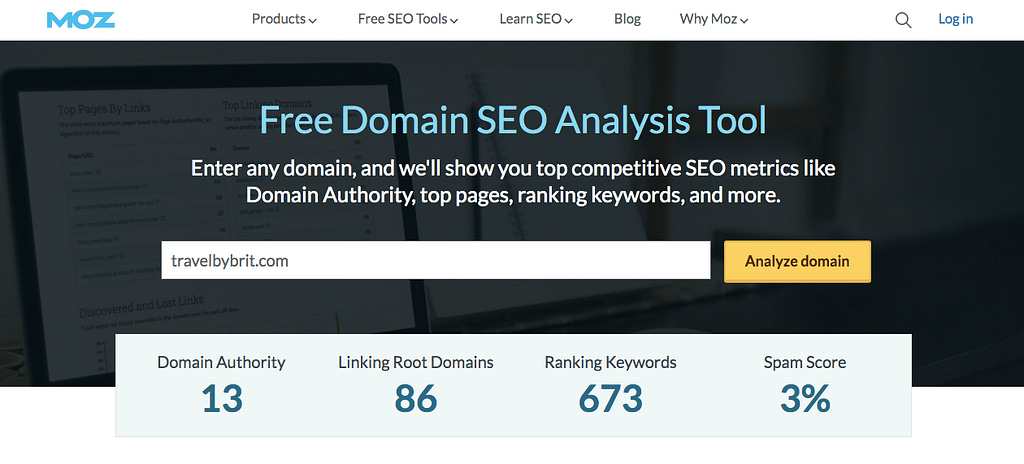
Tip #7: Monitor Your Analytics
Writing new blog posts is a lot of hard work. It takes several hours to research, write, edit, optimize, and promote a post, which is why it’s important to track your analytics.
Tracking your blog analytics is a great way to track your progress, and it also helps you see which posts are performing well. I recommend using Google Analytics for the most comprehensive overview of your performance. Typically, the most critical number for travel bloggers is pageviews—this is how many times your blog is visited per month. However, you can also see your best-performing keywords, traffic sources, demographic information, and more.
Here are some ways you can leverage your analytics to grow your travel blog:
- Optimize old posts. If you have some old posts that aren’t written for SEO, optimizing them can eventually result in a massive traffic spike. Or, if one of your blogs isn’t ranking for a keyword, try incorporating another keyword instead.
- Boost well-performing posts. If you notice a particular post is performing well, determine how you can leverage that. Can you write a new blog post about a correlating topic? Share this post on your social media channels?
- Discover growth opportunities. Do you have a post that’s ranking on Google’s second page? Maybe adding some additional content or re-optimizing this post will help boost it to the first page. Or, getting a few more do-follow backlinks to their page would be another useful strategy.
Tip #8: Don’t Stress Over Social Media
I thought I had to have a huge social media presence to be successful as a travel blogger. I was wrong.
Personally, social media is a time-consuming task that takes away from activities that grow websites, like writing. Aside from Pinterest (a search engine) and Facebook (engagement groups), my blog saw less than 15 monthly users (out of nearly 6,000 users) from social media platforms like Instagram, Twitter, TikTok, Snapchat, etc.
Social media is not a huge part of my growth strategy. It’s a great way to connect with my blogger friends & loyal readers, but it’s not super productive in terms of growing my blog. I honestly don’t think my blog would have grown as quickly as it did over the past year if I was also focused on growing my social media.
However, I do think leveraging social media for your blog can be helpful in these instances:
- If you have a large following. If you already have a large, loyal following on social media that you know will read your posts, definitely focus on maintaining your audience.
- If you’re a photographer. If you’re a photographer, you’ll have great success using Instagram to leverage traffic to your blog! You may want to consider sharing photography tips on your blog, too.
- If you want to be an influencer. If you want to partner with brands to do collaborations and paid sponsorships, you’ll need to have a consistent social media platform.
Bottom line: If you want to make the bulk of your blogging income from brand collaborations, you need to grow your social media. If you want to make the bulk of your blogging income from passive streams, like affiliate marketing and ads, you don’t need to rely on social media as much, and you should primarily focus on your blog.
How to Start a Travel Blog: My Blogging Habits
Looking for the perfect recipe for how to start a travel blog? In summary, these are the things that I have done consistently that I truly believe have helped my blog to grow:
- Publish a new blog post every two weeks
- Create & pin one fresh pin daily
- Pin 10-20 other pins daily
- Participate in BPS three to four times each month
- Obtain 3-5 do-follow backlinks per month
- Review website analytics once per week
- Re-optimize old blog posts for better keywords
How to Start a Travel Blog: Tools You’ll Need
As an easy reference, here are the tools/websites/groups that I talked about that I use frequently:
- Ubersuggest (SEO Research)
- Canva (Pinterest Design)
- RankMath (SEO Optimization)
- WordPress (Content Management Platform)
- Lightroom (Photo Editing Tool)
- Google Analytics (Analytics Tracker)
- Wandering Women Travel Bloggers & Women Travel Creators (Facebook Engagement Groups)
- Travel Collabs & Link Swaps and Travel Collab Post Opportunities (Facebook Backlink Groups)
- Moz (Domain Authority Checker)
- Pinterest (Search Engine)
- Team Travel Blog Babes (Pinterest Engagement Group)
Ready to Watch Your Travel Blog Succeed?
If you’ve been wondering how to start a travel blog, I hope this is your sign to dive right in! Did you learn something new? Let me know in the comments!
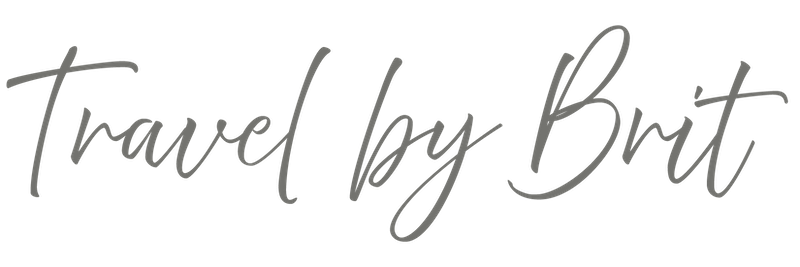

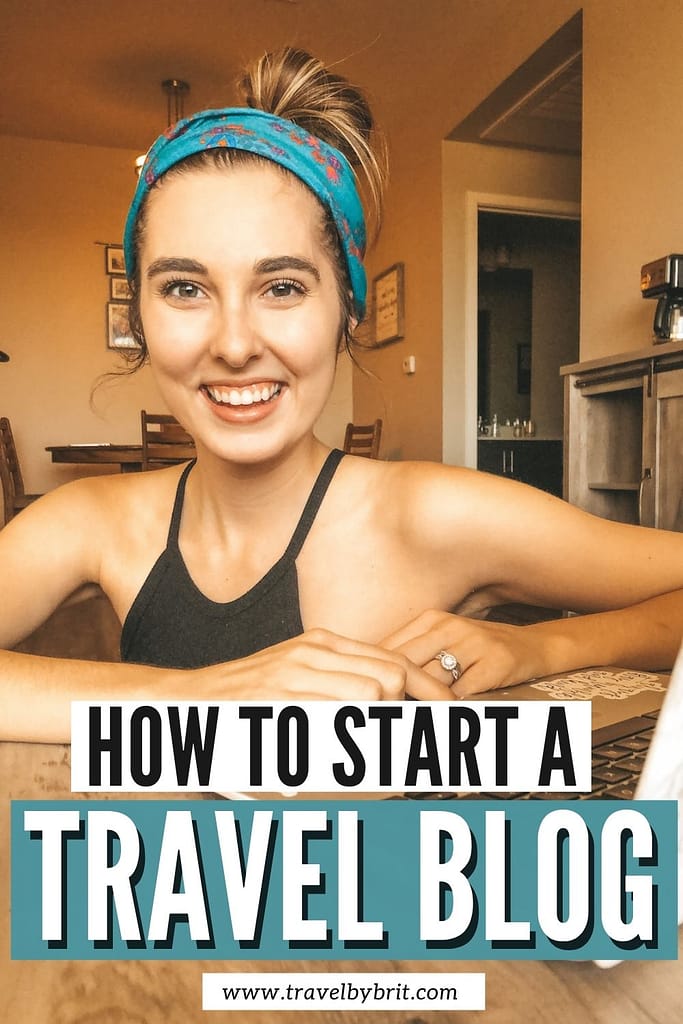

28 comments